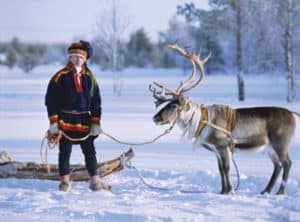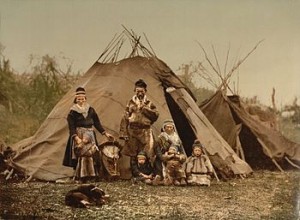In the Lands of the Midnight Sun lives the Sami, formerly called the Lapps by the Scandinavians, are the indigenous people of the far north of Finland, Sweden, Norway and Russia. Their language is Finno-Ugric, related to Finnish and Hungarian. The Sami people’s traditional, semi-nomadic subsistence ways include reindeer herding and fishing and hunting. Their clothing, handicrafts and music are distinctive. The Sami are thought to descent from a people who reached Finland after the end of the last Ice Age. When they got to Finland, at first they occupied the southern parts of Finland, and from there, started to migrate towards Lapland. Today there are more than 70,000 Sami, from whom over 40,000 live in Norway, Sweden up to 25,000, in Finland 6,000 and in Russia 2,000. In Finland the birth-rate amongst Sami is slightly above the average for the country in general, while there are no marked differences in the death-rate. At the same time, the average size of family is very much higher in the case of Sami, 5,7 persons as compared for 3,8 for the Finns, partly as a consequence of the high birth-rate and partly due to the close ties prevailing between the members of the family. There is a Sami Parliament spanning these borders, which participates in the global indigenous peoples’ movement at UN.
Reindeer has always been an important resource of food, clothing, tools and other products to the Sami. They are milked at different stages of  their nomad’s seasonal migration. The meat, fresh or preserved, is excellent, not least because, so far as possible, it is obtained from selected animals which are at their prime age (from 4 to 5 years) not, as with venison from wild deer, when the hunter is able to bag his quarry. It is comparatively lean and unusually rich in proteins and important vitamins. The tongue and marrowbones are delicacies. The blood is used for gruel, pancakes and sausages. Other parts are eaten fresh or preserved. The animals own stomach is cleaned and used to store food. Its intestines serve as sausage casings. One animal produces about 40-65kg of meat.
their nomad’s seasonal migration. The meat, fresh or preserved, is excellent, not least because, so far as possible, it is obtained from selected animals which are at their prime age (from 4 to 5 years) not, as with venison from wild deer, when the hunter is able to bag his quarry. It is comparatively lean and unusually rich in proteins and important vitamins. The tongue and marrowbones are delicacies. The blood is used for gruel, pancakes and sausages. Other parts are eaten fresh or preserved. The animals own stomach is cleaned and used to store food. Its intestines serve as sausage casings. One animal produces about 40-65kg of meat.
From the pelt they can get the finest natural cold-weather clothing available. It is still now a day’s widely used as such throughout the Arctic and is indispensable for bedding and groundsheet. The dressed hide is made into other garments- leggings, tunic and boots. The bones are used to make knife-handles, sheaths, buttons and other small objects. The sinews are traditionally used in the construction of things like sledges or panniers, and for sewing leather objects.
The traditional way of life for the Sami has been the same for centuries. Their economy based almost exclusively on hunting and fishing evolved into one dominated by reindeer husbandry, as reindeer herds were tamed. The Sami led a nomadic lifestyle based around the seasonal migration of their reindeer. In summer time, the animals were herded into the mountains in search of food and cooler temperatures, and in winter they were taken to the shelter of the lowland forests. Until quite recently like many other peoples, had to make their equipment themselves from local materials- wood, bone, leather and roots. Metals for blades, knives and tools came from the outside of their region, but only in small quantities. Their most remarkable way of hunting was pitfalls. Lines of pitfalls were dug along the reindeers’ migratory track in places such as narrow valleys or tongues of firm land in lakes and marshes which limited their freedom of manoeuvre. These pits were oval and 2-3m long, 1-2m broad, 1-2m deep. The hole at the top was carefully concealed by covering of twigs with peat, leaves and moss on top of it.
2-3m long, 1-2m broad, 1-2m deep. The hole at the top was carefully concealed by covering of twigs with peat, leaves and moss on top of it.
On April 1986, when the reactor at the Chernobyl nuclear power plant in Russia exploded, it released a plume of radioactive particles that floated north, and then fell with the rain on Scandinavia. At the time when Chernobyl blew up, the reindeer herds were in the mountains pasturing, marking calves. Later that summer when they brought the reindeer in for slaughtering, many carcasses registered thousands becquerels per kilogram of meat. The legal limit for caesium-137 is 300 becquerels per kilogram. These slaughterhouses were closed immediately. As a result of this, all the sudden, the Sami could not eat their own meat.
The slaughterhouses have re-opened since, but much of the meat is still unfit for human consumption. Still the Sami fear most that the contamination will have long-term consequences for the reindeer. The peculiar ecology of the region and the way the reindeer feed make them particularly vulnerable. The Sami way of life revolves around reindeer. Many of the people fear that if they lose this focus they will lose their cultural identity.
The immediate problems are solved. The fallout from Chernobyl did not fall evenly and some animals avoided contamination. Of 21,000 reindeer slaughtered in October, some 5,000 were below the 300 becquerel mark. So people had enough reindeer meat to eat. If contamination at current levels takes nine years to halve, as some scientists suggest, it will be two generations before many of the reindeer will be clear.
The classic reindeer nomadism is now largely a matter of history. Snowmobiles (Skidoos), cars, motorboats, even helicopters, controlled by telephones and transceivers, are used to manage the reindeer and to carry the loads they formerly bore. The paid hand has taken over from the unpaid member of the family. Cabins have replaced tents at stages on the migration routes. The Sami’s grazing and calving grounds are threatened, or destroyed, by vast developments to provide raw materials, energy, or even holiday amusement, for other peoples. Dams have been building, to get the most out of rivers, but the side effects of these dams are that salmons cannot migrate upstream anymore. Thereby Sami cannot fish anymore, because there is are more fishes. The economic, and thus the social, basis of the old life is under permanent attack. But agriculture and forestry are still the most important sources of income for the Sami, with about 50% dependent on it as their main livelihood.
